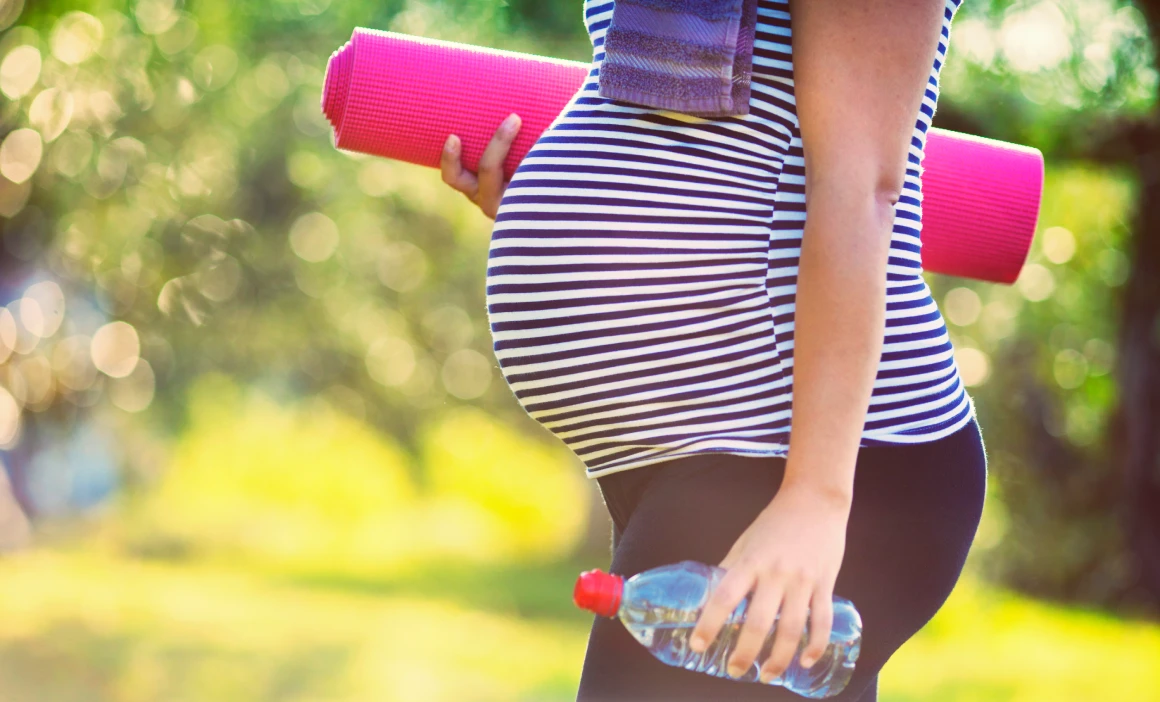
Staying Active During Pregnancy: Safe Exercises and Benefits for You and Your Baby

Cradle of Nutrition
- 6 minutes read
By Erika Barabás
Pregnancy is a time of significant physical and emotional change. As an expectant mother, you may wonder how to best care for your health while supporting your growing baby. One of the best ways to promote a healthy pregnancy is through regular exercise. Research consistently shows that staying active during pregnancy offers numerous benefits, from reducing the risk of complications to improving mood and boosting energy levels.
In this post, we explore why exercise is crucial during pregnancy, the best types of exercise to try, and essential safety guidelines. Additionally, we highlight scientific studies that show how physical activity can improve your pregnancy journey.
Why Exercise During Pregnancy Is Important: Top Health Benefits
Exercise during pregnancy isn’t just about maintaining fitness, it’s about supporting a healthier pregnancy for both you and your baby. Here’s why staying active is so important:
1. Improved Cardiovascular Health
Regular exercise can enhance circulation and reduce the risk of gestational hypertension (high blood pressure) and preeclampsia (a pregnancy-related condition marked by high blood pressure). A study published in the American Journal of Obstetrics and Gynecology (2016) found that moderate-intensity activities like walking or swimming can lower the risk of hypertension during pregnancy.
Research Reference: Mottola, M. F., & Artal, R. (2016) Physical Activity in Pregnancy: Effects on Maternal Health and Pregnancy Outcomes, published in the journal Obstetrics and Gynecology Clinics of North America (Vol. 43, Issue 4, pp. 741-757)
2. Reduced Risk of Gestational Diabetes
Gestational diabetes is a common concern during pregnancy, especially for women who are overweight or have a family history of diabetes. Exercise helps manage blood glucose levels and reduce the risk of gestational diabetes. A 2013 study found that pregnant women who engaged in regular physical activity had a significantly lower risk of developing gestational diabetes compared to inactive women.
Research Reference: Cheng, P. F., et al. (2013) Exercise and Gestational Diabetes: A Review, published in the Journal of Clinical Endocrinology and Metabolism (Vol. 98, Issue 11, pp. 4386-4395).
3. Enhanced Mood and Mental Health
Pregnancy can bring emotional ups and downs, and the hormonal changes can contribute to anxiety, stress, and depression. Regular exercise has been shown to boost the production of endorphins, which help improve mood and reduce feelings of anxiety and depression. A study in 2013 confirmed that pregnant women who exercised regularly reported better mental health and less stress.
Research Reference: Dinan, T. G., & Cryan, J. F. (2013) The Role of Exercise in Mental Health During Pregnancy, published in Obstetrics and Gynecology Clinics of North America (Vol. 40, Issue 2, pp. 365-376)
4. Effective Weight Management During Pregnancy
Excessive weight gain during pregnancy can increase the risk of complications such as gestational diabetes and preeclampsia. A 2012 study found that women who engaged in moderate physical activity were able to manage their weight better during pregnancy, reducing these risks.
Research Reference: Guelinckx, I., et al. (2012) Physical Activity and Weight Management During Pregnancy, published in the Journal of Human Nutrition and Dietetics (Vol. 25, Issue 6, pp. 479-484)
5. Reduced Back Pain and Improved Posture
Back pain is a common discomfort during pregnancy. Regular exercise can help strengthen core and back muscles, improving posture and reducing the strain on your spine. A 2009 study found that prenatal exercise can significantly reduce the incidence and severity of back pain during pregnancy.
Research Reference: Clapis, B. M., et al. (2009) Exercise and Back Pain During Pregnancy: A Randomized Controlled Trial, published in the Journal of Physical Therapy Science (Vol. 21, Issue 2, pp. 85-89)
6. Improved Sleep Quality
Many pregnant women experience sleep disturbances, especially in the third trimester. Regular physical activity helps regulate sleep patterns, resulting in better sleep quality and duration. A 2015 study showed that moderate exercise improved sleep for pregnant women.
Research Reference: Matsumoto, A., et al. (2015) Effects of Physical Activity on Sleep During Pregnancy, published in the Journal of Sleep Research (Vol. 24, Issue 3, pp. 343-348)
7. Easier Labor and Delivery
Active women tend to experience shorter labors, fewer complications, and less pain during childbirth. A study from 2012 revealed that women who exercised regularly throughout pregnancy were more likely to have an uncomplicated vaginal birth and less likely to need a cesarean section.
Research Reference: Mottola, M. F., et al. (2012) Exercise During Pregnancy and the Risk of Cesarean Delivery, published in the Canadian Medical Association Journal (Vol. 184, Issue 10, pp. 1125-1131)
Best Types of Exercise for Pregnant Women: Safe and Effective Workouts
Now that we’ve covered the benefits, let’s explore the best types of exercise during pregnancy. Aim for moderate-intensity activities to reap the benefits without overexerting your body.
1. Walking: Simple, Safe, and Effective
Walking is a great low-impact exercise for pregnant women. It helps maintain cardiovascular health and manage weight gain. Studies suggest that regular walking is safe for most pregnant women and provides a full-body workout without strain.
Why It’s Great: Easy to do, low-impact, and effective for heart and legs.
2. Swimming: Full-Body Workout with Reduced Impact
Swimming offers a full-body workout while being gentle on the joints. The buoyancy of the water supports your growing belly and reduces pressure on your joints, making it an excellent choice if you experience swelling or back pain.
Why It’s Great: Full-body workout, low-impact, reduces swelling.
3. Prenatal Yoga: Stress-Relief and Flexibility
Prenatal yoga is specifically designed for pregnant women to improve flexibility, reduce stress, and maintain muscle tone. Studies show that yoga can also help reduce the perception of pain during childbirth.
Why It’s Great: Improves relaxation, flexibility, and mental well-being.
4. Pilates: Strengthen Your Core
Prenatal Pilates focuses on strengthening your core muscles, improving posture, and relieving back pain. Pilates can help support the spine as your body changes throughout pregnancy.
Why It’s Great: Strengthens the core, improves posture, and alleviates back pain.
5. Stationary Biking: Cardiovascular Health without the Fall Risk
Stationary cycling is a great low-impact exercise that strengthens the legs and improves cardiovascular fitness. It eliminates the risk of falling, which can be a concern during pregnancy.
Why It’s Great: Low-impact, great for cardiovascular health.
Safety Guidelines for Exercising During Pregnancy
While exercise is beneficial, safety is the top priority. Here are essential guidelines to follow:
1. Consult Your Doctor First
Before starting any exercise routine, always consult your healthcare provider, especially if you have pregnancy complications like gestational hypertension or placenta previa.
2. Avoid High-Risk Activities
Steer clear of activities that carry a risk of falling or injury, such as skiing or high-contact sports.
3. Listen to Your Body
Pay attention to how your body feels during exercise. Stop immediately if you experience dizziness, shortness of breath, or discomfort, and consult your doctor.
4. Stay Hydrated
Drink plenty of water before, during, and after exercise to prevent dehydration, which can lead to complications.
5. Wear Proper Gear
Wear comfortable, supportive clothing and footwear. A supportive sports bra and proper shoes are essential.
When to Stop Exercising: Red Flags to Watch For
Stop exercising and seek medical attention if you experience any of the following symptoms:
- Severe shortness of breath
- Chest pain
- Dizziness or fainting
- Severe headaches
- Swelling or pain in the calves
- Vaginal bleeding or fluid leakage
Staying active during pregnancy is one of the most effective ways to support both your health and the well-being of your baby. The benefits of exercise during pregnancy are clear—from improving mood and energy levels to reducing the risk of complications and even easing labor. So, find an activity that works for you, whether it’s prenatal yoga, walking, or swimming. Remember, a healthy pregnancy is a journey, and every step you take toward staying active can make a world of difference. Keep moving, stay strong, and enjoy this beautiful chapter of your life!
For further details on how exercise during pregnancy can impact delivery, check out the following links:
https://www.acog.org/womens-health/faqs/exercise-during-pregnancy
This FAQ from the American College of Obstetricians and Gynecologists (ACOG) provides essential information on the benefits and safety of physical activity during pregnancy.
https://www.who.int/news-room/fact-sheets/detail/physical-activity
The World Health Organization (WHO) offers comprehensive guidelines on physical activity for pregnant women and general recommendations for staying active.






